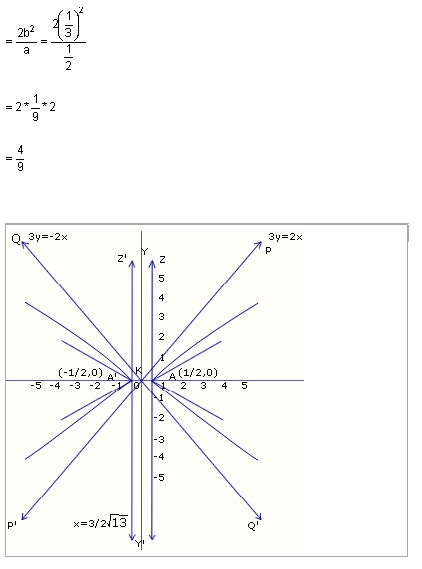Equation of a hyperbola in the standard form
x2/a2 - y2/b2 = 1
Let S be the focus, ZK be the directrix and e the eccentricity of the hyperbola whose equation is required. Draw SK perpendicular from S to the directrix ZK and divide SK internally and externally at A and A1, A1 being on SK, respectively in the ratio e:1.
Then SA = e.AK (1)
SA1 = e.A1K (2)
Since A and A1 are such points that their distances from the focus bear a constant ratio e (>1) to their respective distances from the directrix; therefore, these points lie on the hyperbola.
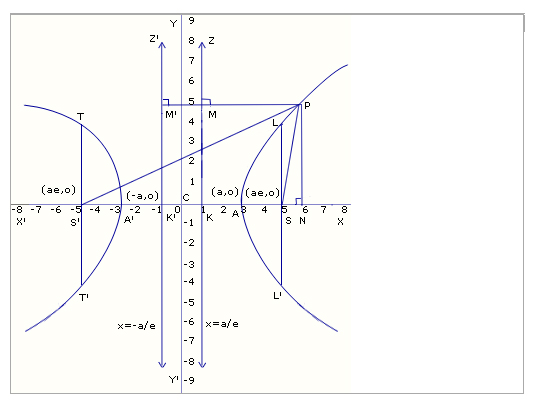
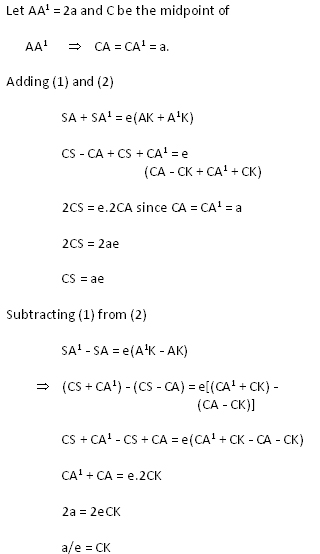
Let C be the origin, CSX the x-axis and a straight line CY through C perpendicular to CX be the y-axis. Let P(x,y) be any point on the hyperbola. PM and PN are perpendicular from P onto ZK and KX respectively. By the definition

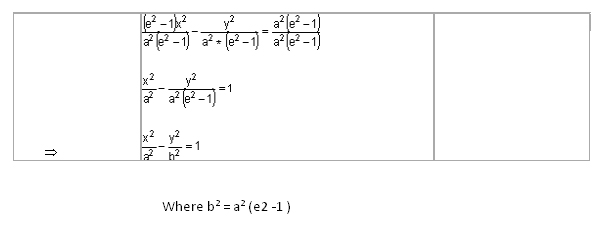
This is the equation of the hyperbola in the standard form.
Tracing a hyperbola

To trace the graph of the hyperbola
- Symmetry:
For every value of x, there are equal and opposite values of y. Similarly, for every value of y there are equal and opposite values of x. Therefore, the curve is symmetric about both axes.
- Origin:
The curve does not pass through the origin.
- Intersection with the axes:
The curve meets the x axis at y = 0. If we put y = 0 in the equation (3), we get x = ± a. The curves meet the x-axis at A(a,0) A1 (-a,0).
If we put x = 0 in equation (2), we get imaginary values for y. So the curve does not meet the y-axis.
- Region:
From equation (2), we find that for -a< x < a the values of y are imaginary. So the curve does not exist between the lines x = -a and x = a. Also, y = 0 at x = ± a, and if x increases and is greater than a, the values of y also increase. Similarly, when it decreases and is less than -a, y also increases.
Second focus and second directrix of a hyperbola
The hyperbola x2/a2 - y2/b2 = 1 , b2 = a2(e2 -1) has a second focus S1(-ae,0) and a second directrix Z1K1 with the equation x = -a/e.
Vertices, Transverse and Conjugate Axes, Foci, Directrices and Center of the Hyperbola:
x2/a2 - y2/b2 = 1
Vertices:
The points A, A1 where the curve meets the line joining the foci S and S1 are called the vertices of the hyperbola. The coordinates of A and A1 are respectively (a,0) and (-a,0).
Transverse and Conjugate Axes:
The straight line joining the vertices A and A1 is called the transverse axis of the hyperbola. Its length AA1= 2a. The straight line through the center, which is perpendicular to the transverse axis, does not meet the hyperbola in real points. But if B, B1 are points on this line such that
CB = CB1 = b, the line BB1 is called the conjugate axis such that BB1 = 2b.
Foci:
The points S(ae,0) and S1(-ae,0) are called the foci of the hyperbola.
Directrices:
The lines ZK and Z1K1 are the two directrices of the hyperbola and their equations are x = a/e and x = -a/e, respectively.
Center:
The midpoint C of AA1 bisects every chord of the hyperbola passing through it and is called the center of the hyperbola.
Eccentricity:
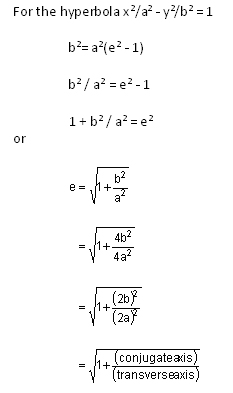
Length of latus rectum:
The hyperbola has the equation
x2/a2 - y2/b2 = 1
If LSL1 is the latus rectum, LS is called the semi-latus rectum.
The coordinates of L are (ae,SL) as L lies on the parabola.
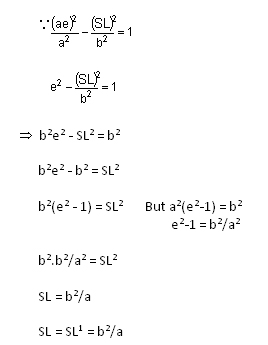
Focal Distances of a Point:
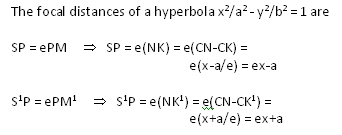
Asymptotes
Definition:
An asymptote is a straight line that meets the conic in two points, both of which are at infinity, but which itself is not altogether at infinity.
Find the asymptote to the hyperbola
x2/a2 - y2/b2 = 1 (1)
The asymptote is a straight line and, hence, can be
written as
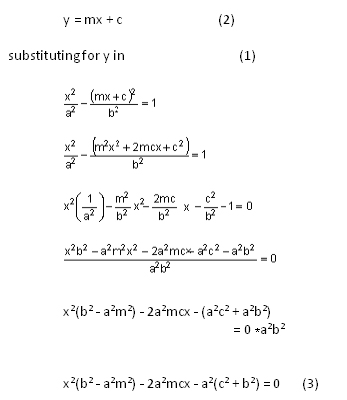
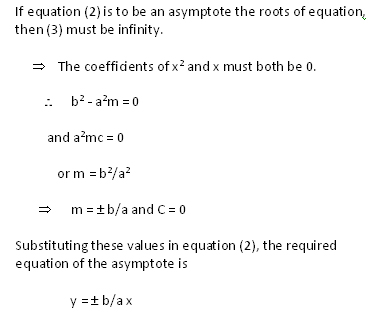
The asymptotes pass through the center but never touch the curve, as given in the figure.
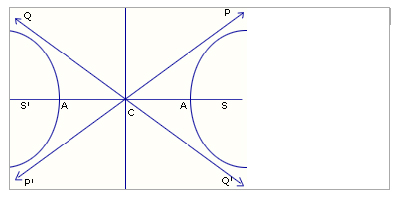
PP1 and QQ1 are the asymptotes.
Conjugate Hyperbola
The hyperbola whose transverse and conjugate axes are respectively the conjugate and transverse axes of a given hyperbola is called the conjugate hyperbola of the given hyperbola.
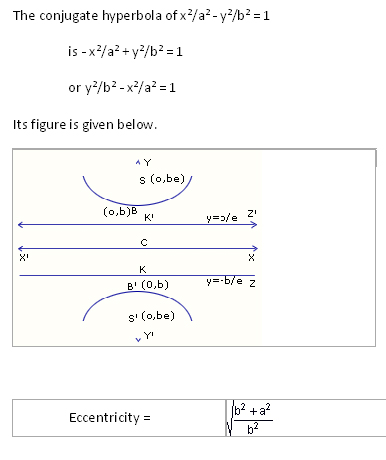
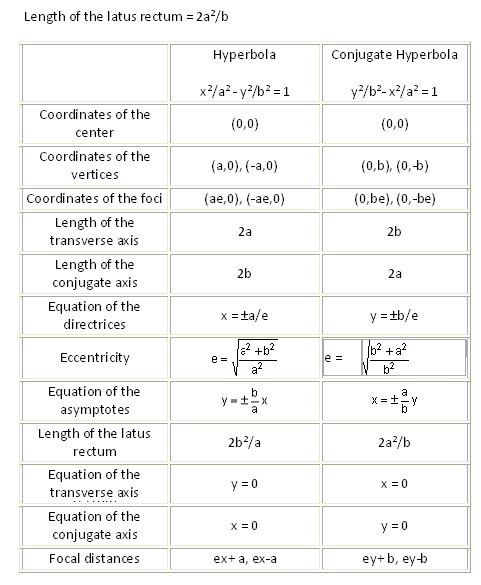
If the center of the hyperbola is at the point (h,k) and the direction of the axes are parallel to the coordinate axes, then its equation is
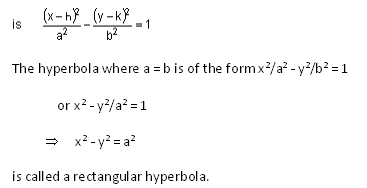
Example 2:
Find the equation of the hyperbola whose focus is (1, 2), directrix is 2x + y = 1 and eccentricity is √3.
Let S(1, 3) be the focus P(x,y) be a point on the hyperbola.
PM = perpendicular from P onto the directrix.
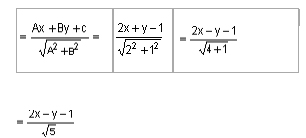
since A = 2 B = 1
For a hyperbola
SP/PM = e
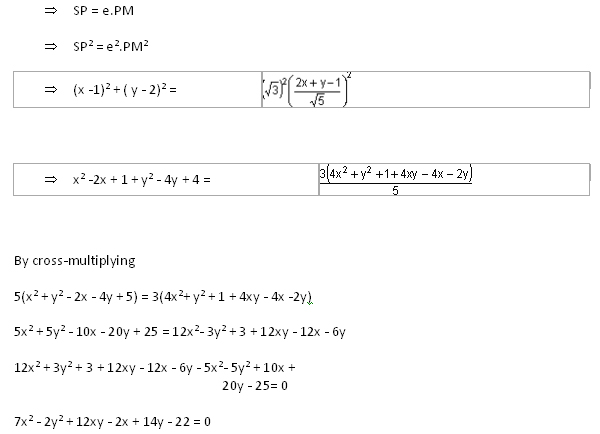
is the required equation to the hyperbola.
Example 3:
For the following hyperbolas, find the lengths of the transverse and conjugate axis, the eccentricity, the coordinates of the foci, vertices, the length of the latus rectum, the equation of the directrices and the asymptotes.
- 16x2 - 9y2 = 144
- 3x2 - 6y2 = - 18
1. Solution:
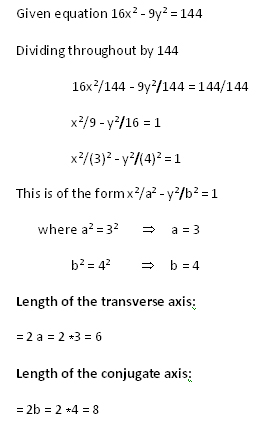
Eccentricity:
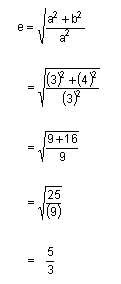
Foci:
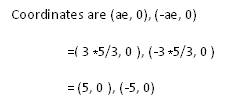
Vertices:
Coordinates are (a, 0), (-a, 0)
= (3, 0), (-3, 0)
Length of the latus rectum:
= 2b2/a
= 2 * 42/3
= 2 * 16/3
= 32/3
Directrices:
Equation to the directrices are x = a/e, x = -a/e
= 3/(5/3) = -3/(5/3)
x = 9/5 x = -9/5
Asymptotes:
Equation to the asymptotes

2. Solution:

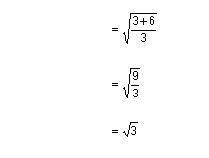
Foci:
Coordinates of the vertices are (0, be), (0, -be)
= (0, √3*√3), (0, -√3 * √3)
= (0, 3), (0, -3)
Vertices:
Coordinates of the vertices are (0, b), (0, -b)
= (0, √3), (0, -√3)
Length of the latus rectum:

Directrices:

Asymptotes:
Equation for the asymptotes
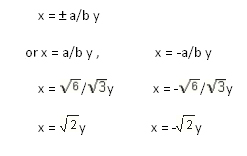
The graph of the above hyperbola is as below.
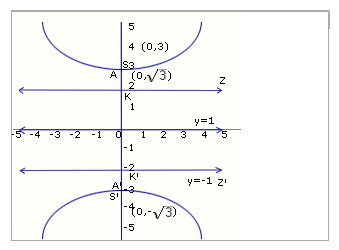
Example 3:
Show that the equation 9x2 - 16y2 - 18x + 32y - 151 = 0 represents a hyperbola. Find the coordinates of the center, foci, vertices, the eccentricity, the lengths of the latus recta, axes, the equation of the directrices and the asymptotes.
Solution:
Given equation 9x2 - 16y2 - 18x + 32y - 151 = 0
For brevity's sake, we will only prove
h2> ab
h = 0; a = 9; b = -16 (from the equation)
h2 = 0
ab = -144
0 > -144
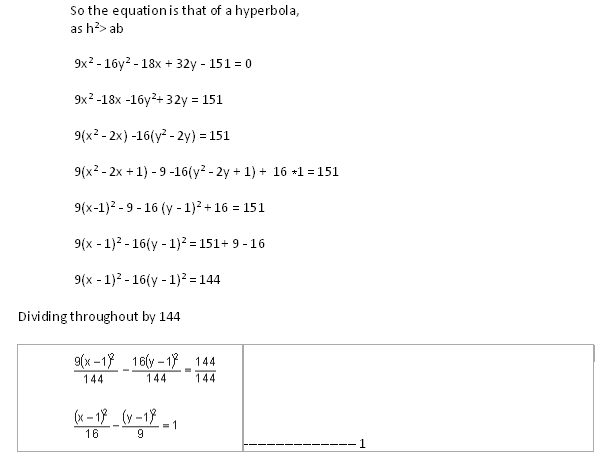
Shifting the origin to (1,1) and denoting the new coordinates with respect to the new axis as X,Y
x-1 = X
x = X + 1
y - 1 = Y
y = Y + 1
Equation (1) reduces to
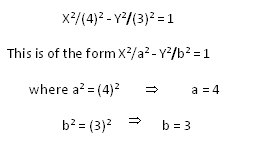
Center:
The coordinates of the center with respect to the new axis is (0,0) with respect to the old axes
x = X + 1
= 0 + 1
x = 1
y = Y + 1
= 0 + 1
y = 1
Center is (1, 1)
Length of the transverse axis:
= 2a = 2 * 4 = 8
Length of the conjugate axis:
= 2b = 2*3 = 6
Eccentricity:
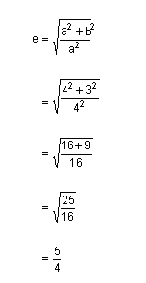
Foci:
With respect to the new axes, the coordinates of the foci are (ae, 0), (-ae, 0)
= (4 * 5/4, 0 ), (-4 * 5/4 , 0 )
= (5, 0 ), (-5, 0)
With respect to the old axes
x = X + 1
= 5 + 1
x = 6
y = Y + 1
= 0 + 1
y = 1
and
x = X + 1
= - 5 + 1
x = - 4
y = Y + 1
= 0 + 1
y = 1
Coordinates of the foci are (6, 1), (-4, 1)
Vertices:
With respect to the new axis, the vertices are (a, 0), (-a, 0)
= (4, 0), (-4, 0)
With respect to the old axis
x = X + 1
= 4 + 1
x = 5
y = Y + 1
= 0 + 1
y = 1
and
x = X + 1
= -4 + 1
x = -3
y = Y + 1
= 0 + 1
y = 1
Vertices are (5, 1), (-3, 1)
Length of the latus rectum:

Directrices:
Equation to the directrices with respect to the new axes are
x = a/e x = -a/e
= 4/5/4 =-4/5/4
X = 16/5 and X = -16/5
With respect to the old axes
x = X + 1
= 16/5 + 1
= 16+5/5
x = 21/5
5x = 21
or 5x - 21 = 0
x = X + 1
= -16/5 + 1
= -16 + 5 / 5
x = -11/5
5x = -11
or 5x + 11 = 0
are the equation of the directrices.
Asymptotes:
With respect to the new axes, the equations for the asymptotes are
Y = ± b/a X
Y = ± 3/4 X
With respect to the old axes
y - 1 = 3/4(x-1) and y - 1 = -3/4(x-1)
4y - 4 = 3x - 3 and 4y - 4 = -3x + 3
3x - 3 - 4y + 4 = 0 and 4y - 4 + 3x - 3 = 0
3x - 4y + 1 = 0 and 3x + 4y - 7 = 0
The graph of the above hyperbola is as below.
The hyperbola 9x2 - 16y2 - 18x + 32y - 151 = 0
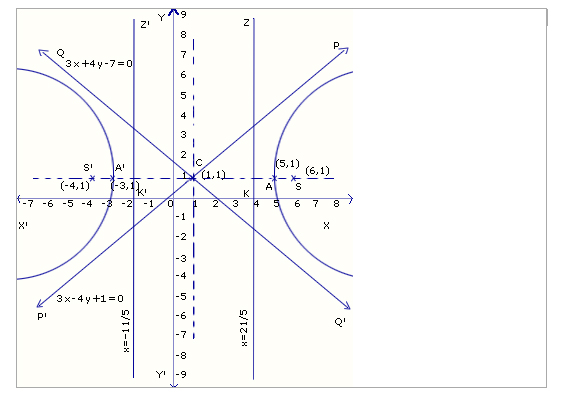
Try these questions
1) Find the eccentricity, coordinates of the foci and vertices, equation of the directrices and asymptotes and length of latus rectum of the hyperbola. Give a rough sketch of the hyperbola.
i. |
3x2 - y2 = 4 |
ii. |
4x2 - 3y2 = 36 |
iii. |
4x2 - 9y2 = 1 |
i. Solution:
Given equation of the hyperbola

Eccentricity:

Foci:

Equation of the directrices are
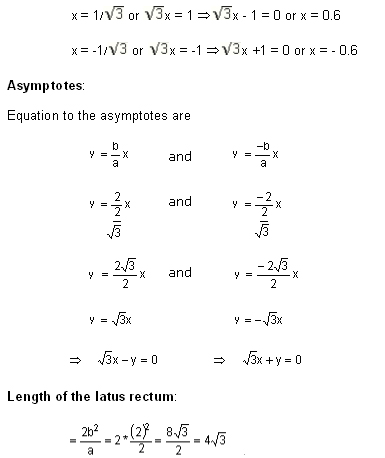
ii. Solution:
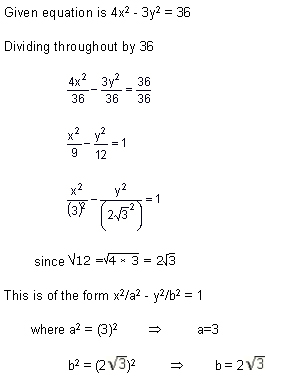
Eccentricity:
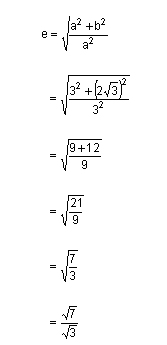
Foci:
Coordinates of the foci ( ae, 0), (-ae, 0)
(ae, o), (-ae,o)
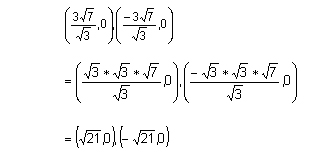
Vertices:
Coordinates of the vertices (a, 0), (-a, 0)
= (3,0), (-3, 0)
Directrices:
Equation of the directrices are
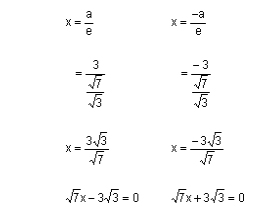
Asymptotes:
Equation to the asymptotes are
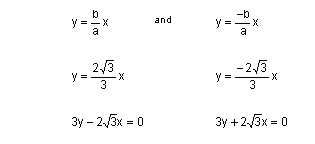
Length of the latus rectum:

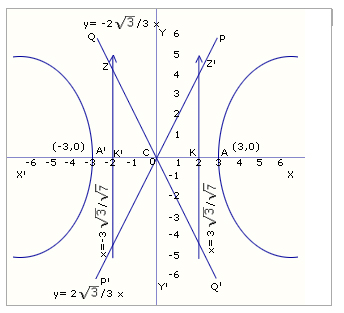
iii. Solution:
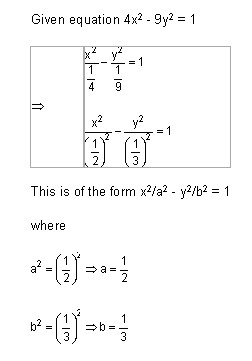
Eccentricity:

Foci:
Coordinates of the foci ( ae, 0), (-ae, 0)
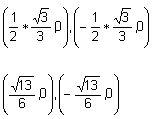
Vertices:
Coordinates of the vertices (a, 0), (-a, 0)
= ( 1/2, 0), ( -1/2, 0)
Directrices:
Equation of the directrices are x = a/e, x = -a/e

Asymptotes:
Equation to the asymptotes are
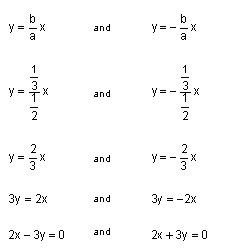
Length of the latus rectum:
